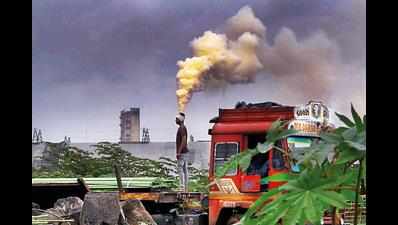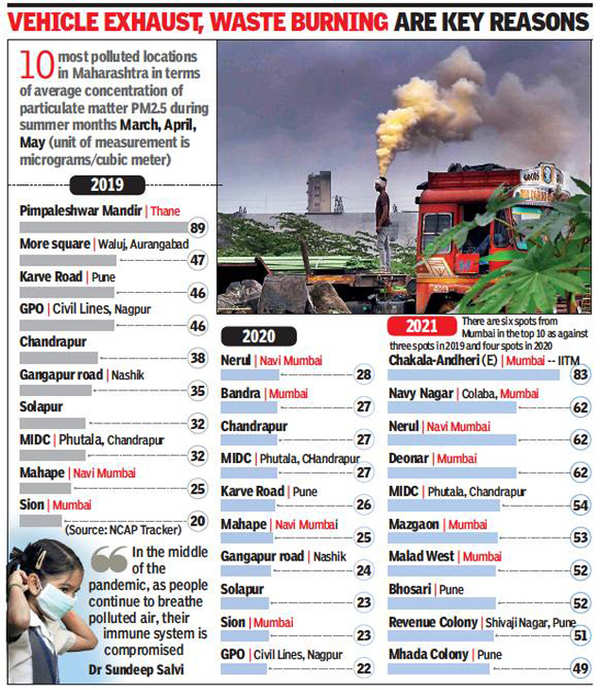- News
- City News
- mumbai News
- MMR has 6 pollution hotspots among top 10 in Maharashtra: Study
Trending
This story is from June 12, 2021
MMR has 6 pollution hotspots among top 10 in Maharashtra: Study
A deadly smog that makes breathing poisonous is no longer a characteristic of winter alone.. Unlike 2020 which was marked by clean air and blue skies during the summer lockdown months, the metropolis and its surroundings have contributed not only more pollution hot spots this year, but experienced a rise in levels of atmospheric particulate matter, according to a recent analysis.

Representative Image
MUMBAI: A deadly smog that makes breathing poisonous is no longer a characteristic of winter alone.. Unlike 2020 which was marked by clean air and blue skies during the summer lockdown months, the metropolis and its surroundings have contributed not only more pollution hot spots this year, but experienced a rise in levels of atmospheric particulate matter, according to a recent analysis.

Chakala in Andheri, Navy Nagar in Colaba, Nerul in Navi Mumbai, Mazgaon, Malad West, and Deonar are the six areas which figure in the list of top 10 most polluted areas in Maharashtra with very high levels of PM2.5 concentration in air (measured in micrograms per cubic meter (ug/m3), according to the analysis based on the NCAP Tracker.
Track the pollution level in your city
In 2019, the Mumbai metropolitan region had three spots among the 10 most polluted in Maharashtra (Pimpaleshwar in Thane, Mahape in Navi Mumbai and Sion in Mumbai) and four in 2020 (Nerul, Bandra, Mahape and Sion).
In Mumbai, experts with the pollution board say the reason for the city’s particulate load is vehicle pollution followed by dust and smog emanating from construction sites, waste burning (incinerators) and industrial emissions.
Between March to May 2020, when a lockdown was enforced, even the most polluted locations had a PM 2.5 concentration of slightly over 25 ug/m3, which is the WHO’s daily safe limits.
But in 2021, pollution levels have increased over the previous year as well as a year before. In 2019, six out of 10 most polluted locations in the state recorded PM 2.5 concentration of less than the CPCB-mandated 40 ug/m3 but in 2021, all locations on the list breached that mark.
Dr Arun Sharma, president, Society for Indoor Environment, says, such high pollution could lead to increased instances of chronic obstructive pulmonary disease, allergies, bronchial asthma.

Chakala in Andheri, Navy Nagar in Colaba, Nerul in Navi Mumbai, Mazgaon, Malad West, and Deonar are the six areas which figure in the list of top 10 most polluted areas in Maharashtra with very high levels of PM2.5 concentration in air (measured in micrograms per cubic meter (ug/m3), according to the analysis based on the NCAP Tracker.
Track the pollution level in your city
NCAP Tracker does a review of the national clean air programme implementation and impact assessment through which government aims to reduce particulate matter (PM) pollution by up to 30%. The tracker sources data from the Central Pollution Control Board. The platform has been developed by CarbonCopy and Respirer Living Sciences.
In 2019, the Mumbai metropolitan region had three spots among the 10 most polluted in Maharashtra (Pimpaleshwar in Thane, Mahape in Navi Mumbai and Sion in Mumbai) and four in 2020 (Nerul, Bandra, Mahape and Sion).
In Mumbai, experts with the pollution board say the reason for the city’s particulate load is vehicle pollution followed by dust and smog emanating from construction sites, waste burning (incinerators) and industrial emissions.
Between March to May 2020, when a lockdown was enforced, even the most polluted locations had a PM 2.5 concentration of slightly over 25 ug/m3, which is the WHO’s daily safe limits.
But in 2021, pollution levels have increased over the previous year as well as a year before. In 2019, six out of 10 most polluted locations in the state recorded PM 2.5 concentration of less than the CPCB-mandated 40 ug/m3 but in 2021, all locations on the list breached that mark.
Dr Arun Sharma, president, Society for Indoor Environment, says, such high pollution could lead to increased instances of chronic obstructive pulmonary disease, allergies, bronchial asthma.
End of Article
FOLLOW US ON SOCIAL MEDIA










